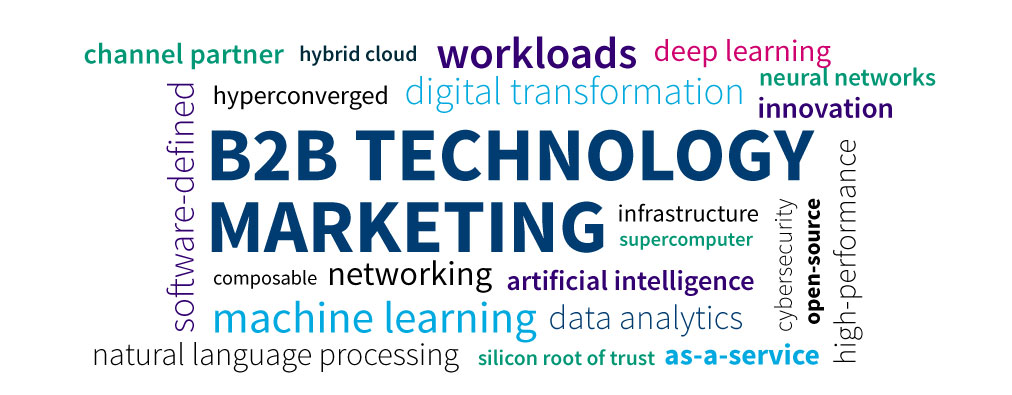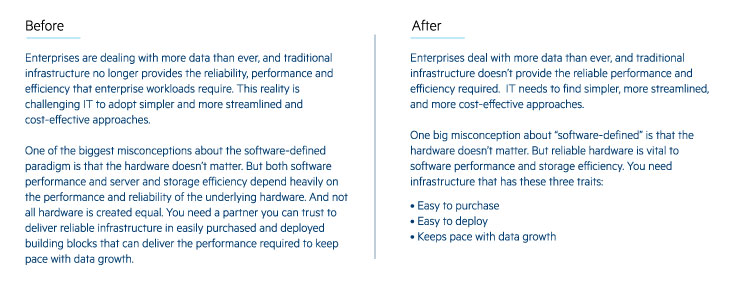How to choose the right B2B tech marketing agency
January 25, 2023
By Craig Clarke
November 5, 2021

As we’ve covered here previously on our blog, proofreading helps ensure the quality of your marketing materials. But proofreading in the B2B technology marketing industry is different from other branches of marketing, let alone areas like journalism or academics.
Here are a few ways B2B tech proofreaders do things differently to serve the particular needs of our clients.
Much like the products and solutions they sell, B2B tech companies have to move fast to stay competitive. To do this, they create a continuous stream of marketing materials. These include videos, blogs, slide decks, social media posts, technical papers, brochures, infographics, and every other method they can think of to get the word out.
These often all need to be ready by a single launch date, or before. Technology advances at an alarming rate, and there’s a short span of time to capitalize on the newness of the offering before competitors catch up and the advantage is lost. (We hear “ASAP!” a lot.)
A client might give us a project in the morning and want it back within hours. It has to go through project management, proofreading, design, and review all in that time. A quick turnaround is important, but so is consistency of presentation. A single campaign can have dozens of separate deliverables, and they must all follow the client’s preferences for editorial style and visual branding.
Occasionally, there are projects a proofreader can devote an entire week to, but those are rare. The average day has us proofreading the work of multiple clients, and it can be difficult to keep all the different preferences separated in our minds.
So, we keep a library of reference material on hand. And by necessity, there’s a lot of it.

Each client has a folder in our proofreading library that contains all of the style and brand guidelines. A style guide is essentially a list of decisions that have been made and documented so they can be referenced (and not re-decided) whenever the situation comes up. This way, usage questions can be quickly answered.
Examples of typical usage questions that a style guide answers:
A few of our clients have comprehensive corporate style manuals, which are helpful to ensure consistency throughout all that client’s materials. After all, we specialize in creating marketing materials “on brand,” which means we make them look and read just like the company’s own.
Large organizations may need so much marketing content that they hire multiple agencies and production shops. All of that needs to look the same. Brand and style guidelines ensure that is the case.
One look at the publicly available writing style guides of either Microsoft or Red Hat gives a sense of the volumes one can contain. Much like the Chicago Manual of Style grew from being the bible for the University of Chicago Press to other publishers, Microsoft’s guide has steadily become the standard for technology companies (Swisher and Preciado, The Personalization Paradox).
When the client company has not developed a fully comprehensive style guide, we create a style sheet for our library based on what information we can glean from their previous publications. (We correct any discrepancies when we receive official feedback.)
We enter the most often encountered style information (trademarks, commas, dates/times, and special terminology) into a tip sheet for that client. The tip sheet is much shorter and allows for easy reference during the tight turnaround times.
Given these tight turnaround times, any requested copyediting needs to be done during the initial proofreading pass. Copyediting while proofreading is not a generally accepted proofreading practice, but the speed and volume of B2B tech marketing requires a different approach.
(Many people don’t know the difference between copyediting and proofreading. That’s not you, obviously. This is for the colleague over your shoulder—no, don’t look! And act surprised when they bring it up at lunch.)
While proofreading looks for consistency, spelling, grammar, and style issues, copyediting is more concerned with flow, clarity, and conciseness. It’s important for tech marketers to remember that the person purchasing the product may not be the IT specialist using it. The marketing must speak to both.
Most of the time, our B2B tech marketing copy is written by a professional copywriter. But some clients prefer to leave this responsibility to a subject matter expert who knows the technology closely. This person is usually more focused on getting the technical details right than in communicating the reasons they are important. Other times, the copy is a collection of the work of multiple stakeholders.
These situations require the deft touch of a copyeditor to streamline things and help your potential buyer understand why your tech is the best tech. Ideally, this is all done without infringing too much on the voice or tone of the piece. Sometimes, you just need a second set of eyes to bring out the core information by brushing away the unnecessary extras.

Proofreading B2B tech marketing copy and content is just different. The speed and volume of production, the numerous client preferences to keep up with, and copyediting while proofreading are only three ways. Proofreading is vital in this industry where so much money is at stake and a single typo can result in a negative first impression.
Customers aren’t just paying for innovative technology; they’re looking for a provider with meticulous attention to detail in every area. Any sense that your company is less than credible breaks an unspoken agreement. And once trust is lost, it’s difficult to regain—if you even get a second chance. Most people won’t report their negative feelings; they’ll just move on to the next option.
Choose a proofreading team that specializes in the pace of your industry.
We take pride in a team loaded with smarts, wit, and ideas. If you'd like to have a smarter, wittier inbox filled with ideas each month, subscribe here to the MarketReach Blog, and we will let you know when there is something new you might like!

Need us now? Just want to learn more? We’d love to talk.